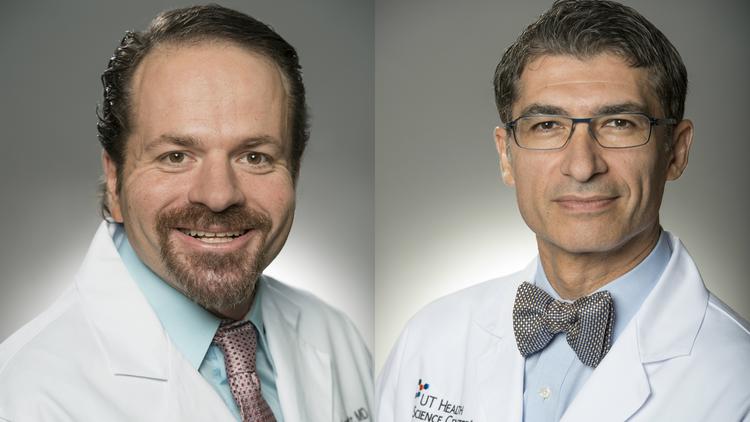Just a few years ago the outlook for treating patients with chronic hepatitis C was grim.
For almost a year, patients would receive a complicated regimen of shots and up to 18 pills a day with drugs that caused major side effects. After that, there was a six-month follow-up period to see if the treatment was successful.

Dr. Eric Lawitz (left) and Dr. Fred Poordad.
IMAGE PROVIDED BY UT HEALTH SCIENCE CENTER
And the cure rate was less than 50 percent.
Thanks to recent research ― some of it conducted in San Antonio ― most patients now can be cured with direct-acting antivirals, a gentler combination of drugs in one or a few pills with only a few months of treatment. Continuing research is promising for new treatments for the groups of patients who don’t respond well to the new standard therapy.
“The good news is patients should know that a paradigm shift has occurred as we now can give all-oral therapy that is simple, safe and highly effective with cure rates of about 95 percent for most patient populations,” said Dr. Eric Lawitz, professor in the School of Medicine at the UT Health Science Center San Antonio.
Lawitz and Dr. Fred Poordad, also a professor of medicine at the UT Health Science Center, see patients at the Texas Liver Institute in San Antonio. They have been researching cures for hepatitis C for years with great success. They have presented oral presentations at international liver meetings and published peer-reviewed articles in major journals that have changed the standard of care for patients.
The FDA-approved drugs they have evaluated include Harvoni (a combination of ledipasvir and sofosbuvir), Olysio (simeprevir), Viekira Pak (ombitasvir, paritaprevir and ritonavir packaged with dasabuvir tablets), Zepatier (elbasvir and grazoprevir) and Daklinza (daclatasvir).
‘Silent epidemic’
The tragedy of hepatitis C is that is that it has no symptoms until the disease progresses, so patients can have the disease for many years and not know it.
“For that reason it is often called a silent epidemic,” Poordad said. “If not identified early, the disease can progress to cirrhosis of the liver, liver cancer and the need for a liver transplant. And even if the patient receives a liver transplant, the disease must be cured or it can infect the new liver.”
What causes hepatitis C?
According to the Centers for Disease Control, hepatitis C is the leading blood-borne disease in the U.S. Although some people have only a mild form of the disease, 75 percent to 85 percent of patients who become infected with the hepatitis C virus will develop a chronic infection. This is estimated to be more than 3.5 million people in the nation.
The virus spreads through contact with the blood of an infected person. This often occurs through sharing needles, syringes or other equipment used in drug use. Another common way is through needle-stick injuries in a health-care setting. Mothers with hepatitis C can pass the disease on to their unborn children. Less common ways of spreading the virus are by sharing toothbrushes and razors, or by having sexual contact with a person who has hepatitis C. Some people contracted the disease years ago through blood transfusions before widespread screening of the blood supply began in 1992.
Find out if you have hepatitis C
According to the CDC, baby boomers ― people born between 1945 and 1965 ― are five times more likely to be infected with hepatitis C than other adults. “You can find out if you have hepatitis C through a simple blood test at your doctor’s office. All you have to do is request it,” Poordad said.
More information about hepatitis C, the blood test for the virus, and the newest treatments are available at the CDC website, www.cdc.gov.
Source: Survival rates rise with new hepatitis C treatments – San Antonio Business Journal






